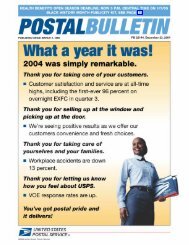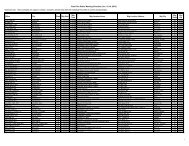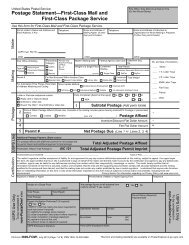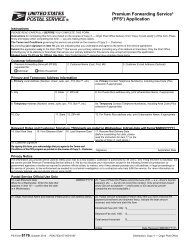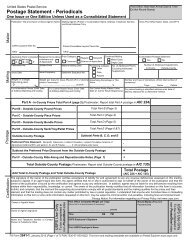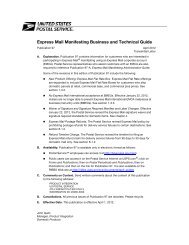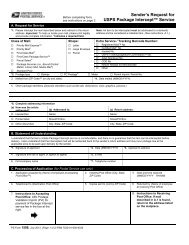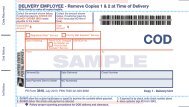2010 Comprehensive Statement on Postal Operations - USPS.com
2010 Comprehensive Statement on Postal Operations - USPS.com
2010 Comprehensive Statement on Postal Operations - USPS.com
You also want an ePaper? Increase the reach of your titles
YUMPU automatically turns print PDFs into web optimized ePapers that Google loves.
The <str<strong>on</strong>g>2010</str<strong>on</strong>g> Annual Performance Report and 2011 Annual Performance Plan<br />
is measured using Delivery C<strong>on</strong>firmati<strong>on</strong> scans that have both<br />
“start-the-clock” and “stop-the-clock” scans. All performance scores<br />
<strong>com</strong>pare actual transit times against the service standard for the<br />
respective category — Overnight, 2-Day, or 3- to 5-Days. Most<br />
Single-Piece First-Class Mail (99.8%) has a service standard of<br />
between 1 and 3 days.<br />
Since the 1980s, External First-Class Mail (EXFC) has been a<br />
rigorous sampling system performed by an external entity that<br />
records transit times between deposit and delivery. Single-Piece<br />
First-Class Mail Internati<strong>on</strong>al is not included in the nati<strong>on</strong>al goal;<br />
however, it is measured and reported separately <strong>on</strong> usps.<strong>com</strong>/<br />
serviceperformance and used as a unit goal.<br />
The c<strong>on</strong>sistent improvement of Single-Piece First-Class Mail<br />
performance over time is the result of sustained focus at all levels<br />
of postal management, in c<strong>on</strong>juncti<strong>on</strong> with multiple activities and<br />
initiatives designed to standardize best practices, improve efficiency,<br />
and eliminate the root causes of delay and process variability.<br />
These efforts, described throughout the <str<strong>on</strong>g>Comprehensive</str<strong>on</strong>g> <str<strong>on</strong>g>Statement</str<strong>on</strong>g>,<br />
include (but are not limited to) <strong>on</strong>going refinements in automati<strong>on</strong><br />
and address recogniti<strong>on</strong>; eliminati<strong>on</strong> of unnecessary handling and<br />
process steps; improvements in visibility and expansi<strong>on</strong> of Intelligent<br />
Mail; and standard use of <strong>com</strong>puterized workforce planning models.<br />
Single-Piece First-Class Mail service standards factor in distance<br />
and transportati<strong>on</strong> availability, the amount of processing required,<br />
and risk. Explanati<strong>on</strong>s for the service standards and other details<br />
<strong>on</strong> service measurement may be found at www.prc.gov/Docs/60/<br />
60194/OrderNo.83Attachment.pdf. All Single-Piece First-Class Mail<br />
categories require processing at an origin postal facility. Mail with<br />
2-Day or 3–5-Day service standards require more processing and<br />
more extensive transportati<strong>on</strong>, with associated risks.<br />
Other Mailing Services. Additi<strong>on</strong>al categories of mailing services<br />
have been measured and reported using pilot or interim systems.<br />
These categories also have service standards and goals. They<br />
receive similar attenti<strong>on</strong> to c<strong>on</strong>tinuous improvement and are also<br />
impacted by similar forces, such as weather.<br />
For a goal to be included <strong>on</strong> the list of a limited number of corporate<br />
goals, it would have to go through the Annual Planning Process<br />
menti<strong>on</strong>ed earlier. It must rely <strong>on</strong> stable systems where processes<br />
are in c<strong>on</strong>trol and are statistically significant at the levels being<br />
measured (e.g., at the district level). As more reliable diagnostic data<br />
be<strong>com</strong>es available, it refines its measurement processes and may<br />
expand the services that are measured. New measurement systems<br />
for other mailing services are summarized below. These systems are<br />
in different stages of maturity and are not included in the corporate<br />
objectives for 2011. Service standards and <strong>on</strong>-time performance for<br />
mailing services are available at usps.<strong>com</strong>/serviceperformance.<br />
Presort First-Class Mail and Standard Mail. Measurement<br />
for <strong>com</strong>mercial letters and flats use similar processes, which<br />
determine performance using tracking from IMb scans with valid<br />
4 | <str<strong>on</strong>g>2010</str<strong>on</strong>g> Performance Report and 2011 Performance Plan<br />
start- and stop-the-clock scans, in c<strong>on</strong>juncti<strong>on</strong> with external data<br />
from the EXFC system. In Quarter 4, the measurement moved from<br />
using a limited number of pilot Full-Service IMb mailers to using<br />
all IMb Full-Service mailings with valid start- and stop-the-clock<br />
scans, totaling over 1.5 billi<strong>on</strong> pieces per week. This is measuring<br />
a census of mail with an IMb instead of being a sampling system<br />
like EXFC. Intelligent Mail includes many aspects such as electr<strong>on</strong>ic<br />
documentati<strong>on</strong> (details in the <str<strong>on</strong>g>Comprehensive</str<strong>on</strong>g> <str<strong>on</strong>g>Statement</str<strong>on</strong>g> ).<br />
Automati<strong>on</strong> equipment passively reads the barcodes and sends the<br />
informati<strong>on</strong> back to a centralized database. As more mail stays <strong>on</strong><br />
automati<strong>on</strong>, such as FSS, there will be more robust informati<strong>on</strong> that<br />
will provide statistically reliable results throughout the country. As the<br />
system matures, it will help improve performance measurement by<br />
extending coverage to more mail categories and mail volume and by<br />
providing more detail for analysis and acti<strong>on</strong>.<br />
Periodicals. Current tracking <strong>com</strong>bines data from two external,<br />
independently-operated systems used by the publishing industry.<br />
Service is measured using mailer-reported entry times to start the<br />
clock and external reporter delivery dates. Since this process is<br />
not representative of all publicati<strong>on</strong>s and is not statistically valid,<br />
a system that uses broad participati<strong>on</strong> in IMb will replace it with<br />
a more robust system similar to <strong>com</strong>mercial First-Class Mail and<br />
Standard Mail.<br />
Package Services. Service is measured using transit time<br />
from deposit at a Post Office to delivery for parcels with Delivery<br />
C<strong>on</strong>firmati<strong>on</strong>. The system measures service to and from virtually all<br />
3-Digit ZIP Code areas. Systems are not yet fully in place to measure<br />
the <strong>on</strong>-time performance for Presort Package Services and at this<br />
point available data includes too little of the overall populati<strong>on</strong> to be a<br />
representative measure.<br />
Special Services. There are a number of special services and<br />
performance is measured using a variety of systems. For all of<br />
these services, the measured result is <strong>com</strong>pared with the respective<br />
service standard to determine performance. Results are included <strong>on</strong><br />
usps.<strong>com</strong>/serviceperformance.<br />
Customer Experience. The <strong>Postal</strong> Service maintains <strong>on</strong>e of the<br />
nati<strong>on</strong>’s largest survey-based customer experience measurement<br />
programs, supplemented by mystery shopper visits. The survey<br />
examines a wide range of postal interacti<strong>on</strong>s with c<strong>on</strong>sumers, small<br />
businesses, and large <strong>com</strong>mercial mailers. These include sending<br />
and receiving mail, c<strong>on</strong>tacts with service employees, and other<br />
issues important to customers. In additi<strong>on</strong>, independent observers<br />
(mystery shoppers) visit Post Offices and use postal help-lines to<br />
assess performance. All this informati<strong>on</strong> is provided to managers<br />
to improve performance, which is <strong>on</strong>e of the reas<strong>on</strong>s the American<br />
Customer Satisfacti<strong>on</strong> Index has listed postal services as the most<br />
improved of all services measured since 1994.




